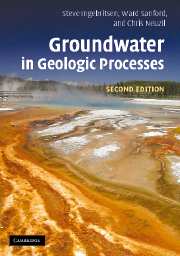Book contents
- Frontmatter
- Contents
- Preface
- Acknowledgements
- List of symbols
- 1 Groundwater flow
- 2 Hydromechanical coupling
- 3 Solute transport
- 4 Heat transport
- 5 Regional-scale flow and transport
- 6 Ore deposits
- 7 Hydrocarbons
- 8 Geothermal processes
- 9 Earthquakes
- 10 Evaporites
- 11 Compaction and diagenesis
- 12 Metamorphism
- 13 Subsea hydrogeology
- References
- Index
3 - Solute transport
Published online by Cambridge University Press: 12 January 2023
- Frontmatter
- Contents
- Preface
- Acknowledgements
- List of symbols
- 1 Groundwater flow
- 2 Hydromechanical coupling
- 3 Solute transport
- 4 Heat transport
- 5 Regional-scale flow and transport
- 6 Ore deposits
- 7 Hydrocarbons
- 8 Geothermal processes
- 9 Earthquakes
- 10 Evaporites
- 11 Compaction and diagenesis
- 12 Metamorphism
- 13 Subsea hydrogeology
- References
- Index
Summary
The transport of dissolved chemical mass, or solutes, in groundwater comprises a significant component of many geologic processes. Many forms of metasomatism and diagenesis, for example, are driven by chemical reactions whose components are supplied by flowing groundwater. In addition, accumulations of hydrocarbons and metal-rich ore deposits are greatly controlled by the transport of chemicals by flowing groundwater. Groundwater also plays a role in the formation and dissolution of evaporite deposits. Detailed examples of how groundwater affects metasomatism, diagenesis, evaporites, and the formation of ore and hydrocarbon deposits will be discussed in later chapters. In this chapter we introduce the basic principles of solute transport in groundwater. As the chapter progresses we discuss the governing equations, techniques for solving these equations, variable-density flow and transport, multiconstituent reactive transport, ultrafiltration and, finally, the role of microbes.
In this chapter, all solute components will be assumed to be miscible with the aqueous phase. Although miscible transport is adequate for describing many geologic processes, many others, such as hydrocarbon migration and steam transport in hydrothermal systems, involve the movement of two or more fluid phases. Multiphase systems require additional considerations that will be left for discussion in Chapter 7 for hydrocarbon phases and Chapters 4 and 8 for the steam phase.
Governing equations
As is the case for groundwater flow, solute transport can be described mathematically by combining principles of mass balance with expressions that relate the fluxes of solute to fundamental driving forces. Solutes move by molecular diffusion, advection, and hydrodynamic dispersion. Sources and sinks of solutes (e.g., chemical reactions) can also be incorporated into solute-transport equations. If multiple solutetransport equations are written for different solutes, and these equations are coupled with the groundwater flow equation (Section 1.5), they can be used to quantify many of the reactive-transport processes that occur in the subsurface.
Molecular diffusion
In Chapter 1 we introduced Darcy's law as the flux of fluid resulting from a gradient in fluid potential or hydraulic head (Eq. 1.2). An analogous situation exists for solute transport – diffusive flux of chemical mass results from a gradient in the chemical potential, or concentration. This flux of chemical mass is directly proportional to both the concentration gradient and a coefficient of molecular diffusion.
- Type
- Chapter
- Information
- Groundwater in Geologic Processes , pp. 89 - 123Publisher: Cambridge University PressPrint publication year: 2006



